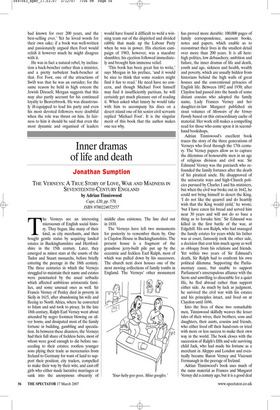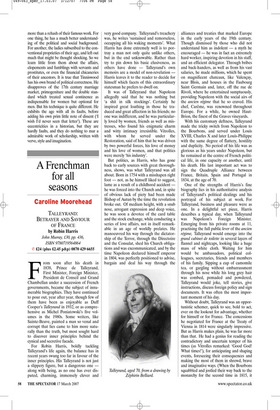Inner dramas of life and death
Jonathan Sumption
THE VERNEYS: A TRUE STORY OF LOVE, WAR AND MADNESS IN SEVENTEENTH-CENTURY ENGLAND by Adrian Tinniswood Cape, £20, pp. 570, ISBN 9780224072557 The Verneys are an interesting microcosm of English social history. They began, like many of their kind, as city merchants, and then bought gentle status by acquiring landed estates in Buckinghamshire and Hertfordshire in the 15th century. Later, they emerged as minor stars at the courts of the Tudor and Stuart monarchs, before briefly entering the peerage in the 18th century. The three centuries in which the Verneys struggled to maintain their name and estates were punctuated by the usual setbacks which affected ambitious aristocratic families, and some unusual ones as well. Sir Francis Verney of Penley died in poverty in Sicily in 1615, after abandoning his wife and fleeing to North Africa, where he converted to Islam and and took to piracy. In the late 18th century, Ralph Earl Verney went about attended by negro footmen blowing on silver horns, and dissipated most of the family fortune in building, gambling and speculation. In between these disasters, the Verneys had their full share of feckless heirs, most of whom were good enough to die before succeeding to their estates; rootless younger sons plying their trade as mercenaries from Ireland to Germany for want of land to support their position; city traders, compelled to make their way by their wits; and cast-off girls who either made lucrative marriages or sank into the anonymous obscurity of middle class existence. The line died out in 1810.
The Verneys have left two monuments for posterity to remember them by. One is Claydon House in Buckinghamshire. The present house is a fragment of the grandiose jerry-built pile put up by the eccentric and feckless Earl Ralph, most of which was pulled down by his successors. The church next door houses one of the most moving collections of family tombs in England. The Verneys’ other monument has proved more durable: 100,000 pages of family correspondence, account books, notes and papers, which enable us to reconstruct their lives in the smallest detail over more than 200 years. It is all here: high politics, low debauchery, ambition and failure, the inner dramas of life and death, youth and age, sickness and health, wealth and poverty, which are usually hidden from historians behind the high walls of great houses and the conventional privacies of English life. Between 1892 and 1930, after Claydon had passed into the hands of some distant cousins who adopted the family name, Lady Frances Verney and her daughter-in-law Margaret published six stout volumes of Memoirs of the Verney Family based on this extraordinary cache of material. Her work still makes a compelling read for those who come upon it in secondhand bookshops.
Adrian Tinniswood’s excellent book traces the story of the three generations of Verneys who lived through the 17th century. The Verney papers allow us to capture the dilemmas of honourable men in an age of religious division and civil war. Sir Edmund Verney was the patriarch who refounded the family fortunes after the death of his piratical uncle. He disapproved of the autocratic ways and high-Church policies pursued by Charles I and his ministers, but when the civil war broke out in 1642, he could not bring himself to desert the King. ‘I do not like the quarrel and do heartily wish that the King would yield,’ he wrote; ‘but I have eaten his bread and served him near 30 years and will not do so base a thing as to forsake him.’ Sir Edmund was killed in the first battle of the war, at Edgehill. His son Ralph, who had managed the family estates for years while his father was at court, famously took the other side, a decision that cost him much agony as well as obloquy from his relations and friends. Yet within two years of Sir Edmund’s death, Sir Ralph had to confront his own political dilemma. Supporting the Parliamentary cause, but unable to support Parliament’s unscrupulous alliance with the Scots and unwilling to dissemble for a quiet life, he fled abroad rather than support either side. As much by luck as judgment, he survived the civil war with his estates and his principles intact, and lived on at Claydon until 1696.
Into the lives of these two remarkable men, Tinniswood skilfully weaves the lesser tales of their wives, their brothers, sons and daughters, their aunts, cousins and friends, who either lived off their hand-outs or tried with more or less success to make their own way in the world. The book closes with the succession of Ralph’s fifth and sole surviving child Jack, who had made his fortune as a merchant in Aleppo and London and eventually became Baron Verney and Viscount Fermanagh in the peerage of Ireland.
Adrian Tinniswood’s book uses much of the same material as Frances and Margaret Verney did a century ago, but it is a good deal more than a rehash of their famous work. For one thing, he has a much better understanding of the political and social background. For another, the ladies subscribed to the conventional proprieties of their age, and left out much that might be thought shocking. So we learn little from them about the affairs, elopements and fumblings with servants and prostitutes, or even the financial chicaneries of their ancestors. It is true that Tinniswood has his own brand of political correctness. He disapproves of the 17th century marriage market, primogeniture and the double standard which treated sexual continence as indispensable for women but optional for men. But his technique is quite different. He exhibits the age with all its faults, before adding his own prim little note of dissent (‘I wish I’d never seen that letter’). These are eccentricities in a historian, but they are hardly faults, and they do nothing to mar a admirable work of scholarship, written with verve, style and imagination.



































































































 Previous page
Previous page